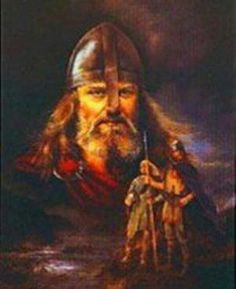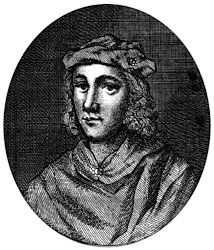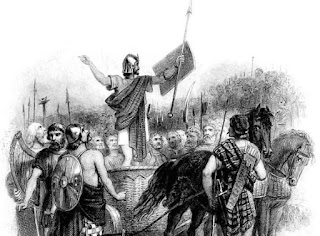Somerled
King of the Isles
Somerled, King of the Isles, was feared and revered in equal measure in the 12th century, during which time he stood like a giant over Scotland's entire north-western seaboard.
For many, his name has retained an almost mythical quality, while others have sought to portray him as an unruly rogue. In fact, he campaigned to defend the Scots kingship and government from what many saw as destructive foreign influences acting on kings David I and Malcolm IV.
Somerled's kingship was in the heart of the ancient and distinctively Scottish Viking-Gael land, and he had Gaelic and Norse origins. His name in Gaelic, Somhairlidh, comes from the Norse sumarlidi meaning 'summer raider' or Viking, and his family was firmly among the ruling Celto-Norse chieftains of the Western Isles in the 11th and 12th centuries.
Little is known about his early life, but by the 1130s Somerled had emerged as an important political figure. His royal titles were Ri Innse Gall, 'King of the Hebrides' and Regulus (or 'Kinglet') of Argyll.
Although Somerled owed traditional allegiance to the Kings of Scots and Norway, he was fiercely independent of both. He established through marriage a network of relations with the most influential figures of the community of the Western Isles. The scope of this Atlantic community encompassed Man, Ireland, the Hebrides, the Orkneys, and Norway.
Political alliances were also cultivated through fosterage and the giving of hostages. These were a means of building up trust and friendly cooperation.
In 1140, when Somerled married Ragnhild, daughter of Olaf of Man, he already had forces of some strength. Sources state that even before this marriage, Somerled had taken Lorn, Argyll, Kintyre, and Knapdale, Mull and, Morvern.
The connections established with big political players like Olaf of Man and Harold Maddadsson, carl of Orkney, enabled Somerled to emerge as the key political figure in the Isles by the 1150s.
His alliances provided him with a potentially vast army of supporters from which to draw in the event of a confrontation with the Scots crown.
Such ties were further enhanced by the cultural distinctiveness of the region, a factor which might well have acted to unite the native barons when in conflict with the crown.
It was essential for Somerled to be a sophisticated political operator. The Isles and the mainland formed two very distinct spheres of influence which had to be balanced carefully if he was to consolidate hihissthighest power.
In the Isles, Somerled had to deal with a powerful tyrant on his southern frontier, Godrafraidh or Godred. Godred was Lord of Man and the Isles whose aggressive conduct unsettled many of his local chieftains.
Around 1156, one such chieftain, Thorfinn MacOttar, sought help from Somerled - who seized the opportunity to establish himself further. Another chieftain named Paul managed to warn Godred, who assembled a fleet of ships and confronted Somerled on the night of the Epiphany that year. The engagement resulted in a two-year truce, brought to an end when the two clashed again in 1158. This time, Somerled sailed to Man with a fleet of 53 warships and put Godred to flight.
Somerled's mainland centre of power was Argyll. His greatest concern was the Scots kingship's policy of thrusting foreign Anglo-Norman settlers westward. These settlers were a key part of the policy of King David I, and especially Malcolm IV, to replace Gaelic government and society with the Anglo-Norman model of feudalism.
But Somerled knew he couldn't fight on two fronts at the same time. When engaged in warfare in the Isles, his relations with the Scottish Crown were peaceable. And when he took on the King of Scots, he first ensured that the Isles were at peace. He also recognised was that cultivating his links with the church were crucial if he was to extend his influence. So he gave patronage to a new-model European religious order, the Cistercians, founding Saddell Abbey in Argyll.
He even tried to tempt the Abbot of Derry, who was head of the Columban monasteries in Ireland, back to lona. Had he succeeded, it would have been a political masterstroke.
Thus the kings of Scots were not alone in following modern trends and appreciating the political importance of the church.
Although Somerled supported King David I in conflict against the English, he was never David I's vassal or underlord as many have asserted.
The relationship between the two was a Gaelic one in which Somerled paid a tribute to David that was little more than an expression of tradition. The feudal concept of vassalage was simply not recognised by Somerled and he governed his province with a high degree of independence.
And David had little choice in the matter of Somerled's meteoric rise to power in the Isles.
David's involvement in English affairs from 1136 meant that he was unable to check Somerled's activities in the Hebrides. It is precisely at the time that David's back was turned that Somerled was busy expanding his power.
While many of Scotland's magnates had grown increasingly unhappy at David I's Anglo-Norman influences, the crowning of Malcolm IV under the Anglo-Norman system of succession outraged them.
David had chosen his son Henry as his heir apparent, as some of his charters make clear. Henry's death, however, meant that the crown then passed to David's grandson, Malcolm.
This foreign system of succession broke Scotland's ancient Gaelic rules. Further aggravating the situation was the fact that Malcolm had not yet reached the age of majority, and was wide-open to manipulation by the Anglo-Normans.
Somerled responded to the threat by attempting to remove Malcolm IV. Somerled's brother-in-law, Malcolm MacHeth, had a claim to the throne through the Gaelic system of succession, and Somerled rebelled with MacHeth's sons, probably in support of their father's claim to the throne.
The underlying motive was to weaken Anglo-Norman influence in Scotland. This rising resulted in a dispute between the kingship of the Isles and the Scottish throne, which eventually ended in a truce in 1159.
Crucially, Somerled was not alone in leading uprisings against the kings of Scots. There were several other rebellions throughout the period 1120-1160, as discontent was rife among Scotland's semi-independent lords.
The native Scottish lords were furious at Malcolm's neglect of his kingdom and felt threatened by his Anglo-Norman barons, who were hungry to carve up the native territories between them. Above all, Malcolm's intimacy and friendship with KingFitz Henry I of England aggravated them greatly.
In response to continued alienation and suppression by Malcolm IV, Somerled headed another invasion of the kingship in 1164. Tensions had grown higher than ever, and he and his allies were desperate to reverse the foreign culture being imposed by the kingship.
According to the 'Chronicle of Man', Somerled assembled a vast fleet of 160 ships and sailed up the Clyde, landing at Renfrew with a considerable body of men. The later historian George Buchanan believed that on this occasion, Somerled was motivated by hopes of achieving the kingdom of Scots himself.
Nothing shows Somerled's personal alienation better than the place he chose to stage the invasion - Renfrew, a great Strathclyde estate held by the most powerful of Anglo-Norman barons - Walter fitz Alan.
We can only speculate about the engagement, but some historians have said there would be a certain historic satisfaction had Somerled and Fitz Alan faced one another on the field at Renfrew.
Also symbolic was the intrusive presence of the Anglo-Norman castle built at Renfrew.
Somerled met his end during this attempted coup, but the events surrounding his death are clouded in obscurity.
There are two conflicting versions of what happened. Pro-Malcolm sources say that there was a huge battle in which Somerled was killed and his forces routed. But others suggest that Somerled's death was a more macabre affair, steeped in treachery and political intrigue.
They record that Somerled was assassinated by his nephew, Maurice MacNeill, who had been bribed by the Anglo-Normans. It is said that Maurice took a little boat, went over the river at Paisley, and sought a private audience with Somerled -whom he then stabbed before making his escape.
There need not be any great contradiction here. If there was a battle, it may have raged on over days, and Maurice could have arranged a fake diplomatic meeting with Somerled during a lull in the fighting. Whatever the cause of Somerled's death, without its leader, the rising collapsed.
According to the Chronicles of St Kentigern, Somerled's head was delivered on a plate to the Bishop of Glasgow, Herbert, as a reward for bringing the spirit of St Kentigern to the aid of Walter Fitz Alan - the first of the Stewarts. The Bishop and his largely Anglo NormanAnglo-Norman clergy attributed the victory to Kentigern.
They also suggested the victory was the work of the Scottish saints in general, proclaiming that "the Scottish saints are truly to be praised!" This claim ignored the fact that most of Somerled's people lived in the heartland of the early Scottish saints.
Somerled's extraordinary life shows that the feudalisation of Scotland was anything but peaceful. Tensions in 12th-century Scotland ran high between natives and newcomers. Many of the Gaelic magnates under David I and Malcolm IV were torn between their Gaelic instincts and their loyalty to the Scottish crown.
Update -
(The severed head of Somerled is delivered, on a plate, to the Bishop of Glasgow, Herbert, as a reward for assisting Fitz Alan )
The manner of Somerled's death has never been definitely established, but it is described graphically in a poem written at the time by a cleric of Glasgow Cathedral:
The deadly leader, Somerled, died. In the first great clash of arms.
He fell wounded by a spear and cut down by the sword;
Their savage leader now laid low, the wicked turned and ran,
But many of them were butchered in the sea as on dry land.
They sought to clamber from the blood-red waves into their ships,
But were drowned, each and all, in the surging tide.













Comments
Post a Comment